
How to Install Air Lift LoadController Single Onboard Air System w/ Standard Duty Compressor on your



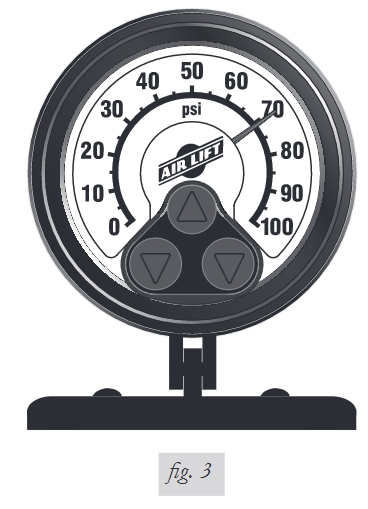
Single analog gauge mounting hardware on bottom of gauge
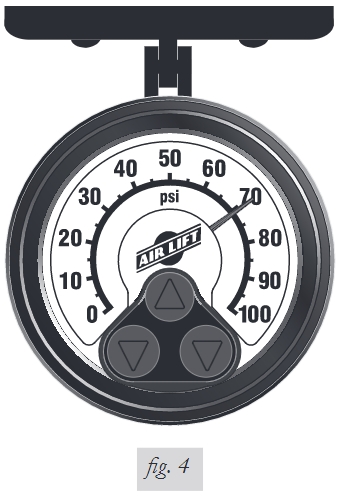
Single analog gauge mounting hardware on top of gauge

Back of analog gauge
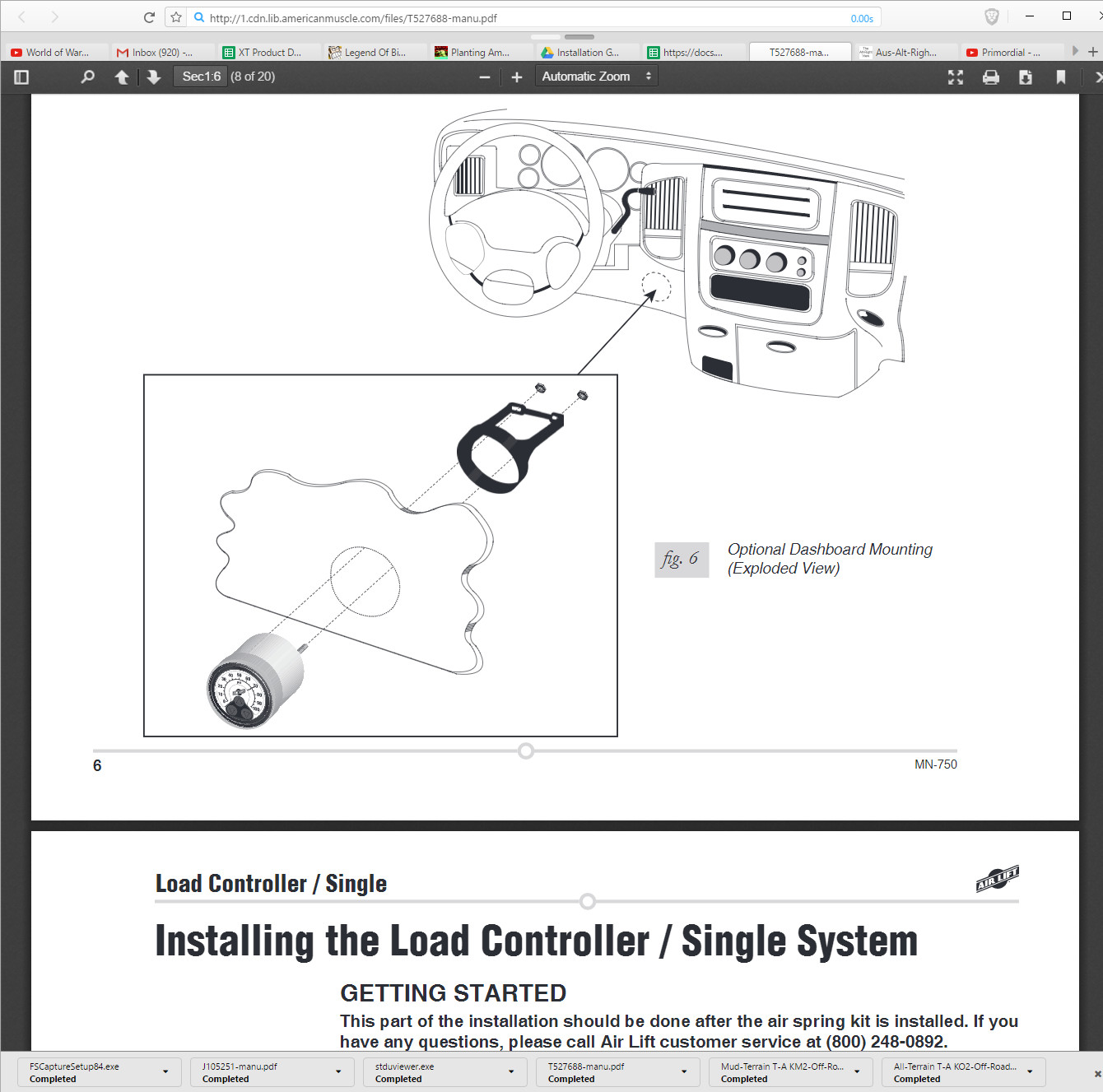
Installing the Load Controller / Single System
GETTING STARTED
This part of the installation should be done after the air spring kit is installed. If you have any questions, please call Air Lift customer service at (800) 248-0892. If you are adding this control system to an Air Lift LoadLifter 5000™ application, then no modifications to the low pressure sensor are necessary. If you are adding this control system to an Air Lift 1000™ or Ride Control™ application, and if your specific application requires a minimum of 10 PSI, then it will be necessary to adjust the low pressure sensor to 10 PSI To increase the pressure in the low pressure sensor, remove the rubber plug with pliers (fig. 7). Using an allen wrench, turn the screw clockwise 4 1/4 turns (fig. 8). Push the rubber plug back into th
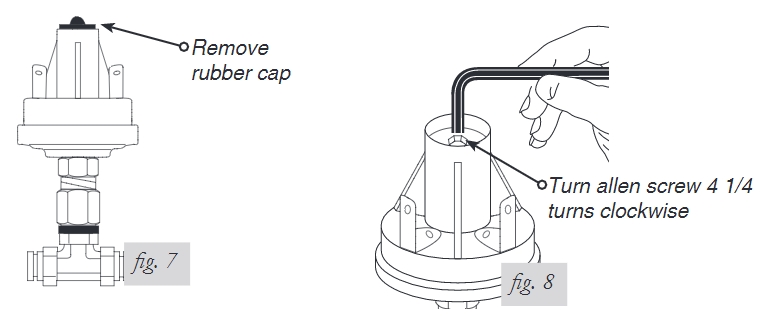
RECOMMENDED COMPRESSOR LOCATIONS
Important
LOCATE COMPRESSOR IN DRY, PROTECTED AREA ON VEHICLE. DIRECT SPLASH OR EXCESSIVE MOISTURE CAN DAMAGE THE COMPRESSOR AND CAUSE SYSTEM FAILURE.
Disclaimer: If you choose to mount the compressor outside the vehicle please keep in mind the compressor body must be shielded from direct splash and the intake should be snorkeled inside the vehicle. If the compressor does not include a remote mount air filter or if mounting the compressor outside the vehicle, make sure to orient the compressor intake filter so that all moisture can easily drain. Please also remember...
• To avoid high heat environments
• To avoid mounting the compressor under the hood.
• To check to be sure the compressor harness #2 will reach the compressor and connect to harness #1. The compressor can be mounted in any position — vertical, upside down, sideways, etc. (please refer to the instruction manual)
STEP BY STEP INSTALLATION We recommend that you install the air spring kit first per the instructions provided with the air spring kit.

1. Install the gauge pod (figs. 3, 4 & 5). Select a convenient mounting location that has a sturdy rigid surface. The bottom edge of the dash on either side of the steering wheel is a good location. Attach the gauge pod to the selected location with the black self-tapping screws. Optional dash mounting bracket and hardware also included (fig. 6).
2. Connect the harness to the gauge pod.
a. Connect the color coded wires to the gauge harness as shown in the attached schematic.
b. Connect the low pressure switch assemblies as shown in figures 2 and 9.
c. Do not connect the power wire at this time.
d. The wiring harness also connects the gauge pod to the low pressure sensor assembly. The low pressure sensor protects the air springs from failure resulting from low pressure in the unloaded condition. This sensor is preset to maintain a MINIMUM pressure of 5 PSI in the air springs unless the setting was changed in the “Getting Started” section. The sensor measures the pressure in each spring and turns on the compressor if the pressure falls below the set PSI.
e. Screw ground eyelet to firewall or other electrical ground in the cab. The sensor should be located under the dash inside the vehicle and secured with the provided tie straps.
3. Install the compressor unit.
a. Hold the compressor in the recommended location (fig. 10 or 11).
b. For box frames: In some cases the frame section will not be wide enough to mount the compressor legs flat to the rail. Refer to figs. 10 and 11 in this situation.
DO NOT DRILL ANY HOLES INTO THE FRAME OR THE FLOOR BOARD BEFORE CHECKING FOR HYDRAULIC LINES, GAS LINES, AND/OR ELECTRICAL WIRES THAT MAY NEED TO BE MOVED ASIDE. ALSO, WHEN ATTACHING TO THE FLOOR BOARD, IT IS IMPORTANT TO CHECK WHERE THE SCREWS PROTRUDE THROUGH THE FLOOR BOARD. IT MAY BE NECESSARY TO TRIM OR COVER THE TOP OF THE SCREWS INSIDE THE VEHICLE. A SEALER SHOULD BE USED AROUND THE SCREW TO PREVENT THE ELEMENTS FROM ENTERING THE CAB AREA.
STANDARD DUTY COMPRESSOR MOUNTING (FIG. 1 - A1, 10)
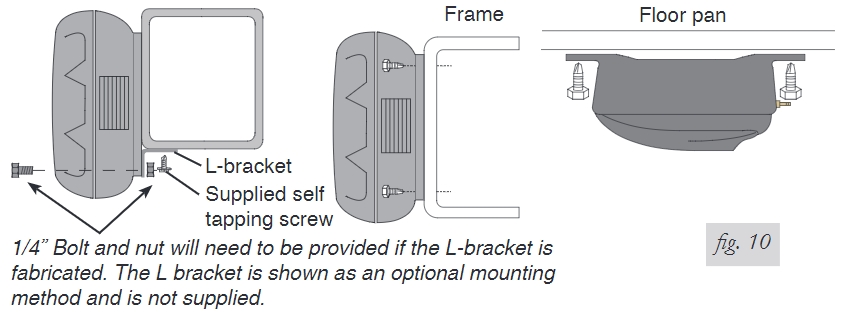
HEAVY DUTY COMPRESSOR MOUNTING (FIG. 1 - A2, 11)
Using the compressor as a template, drill holes and mount the compressor using the black mounting hardware that comes in the box containing the compressor.
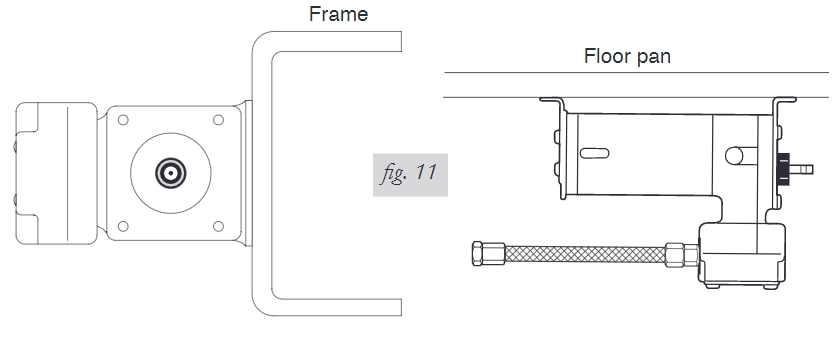
AIR LINE AND POWER WIRES ROUTING FOR THE STANDARD DUTY COMPRESSOR: 1. Push the air line onto the barb fitting on the compressor. Make sure the air line covers all barbs. A small amount of water or lubricant and pushing with a slight circular motion will ease installation (fig. 12).

AIR LINE AND POWER WIRE ROUTING FOR THE HEAVY DUTY COMPRESSOR
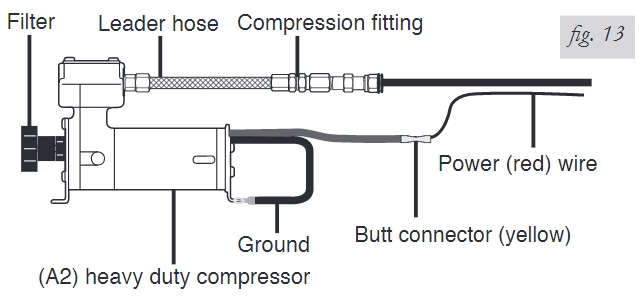
1. Remove the nut from the leader hose and install over air line from check valve assembly.
2. Push the air line from the check valve assembly into the barbed fitting on the compressor leader hose.
3. Slide the nut over the fitting and tighten securely (fig. 13).
4. Route the harness to the compressor. a. Use existing grommets in the floorboard or firewall to route the harness from the cab to the frame mounted compressor. b. In some cases, a hole may have to be drilled to allow access for the harness. Drill a 1” diameter hole and install the provided grommet (fig. 14). It will be necessary to seal any grommets or holes that have been cut, drilled or removed so as not to allow elements to enter the cab area of the vehicle.
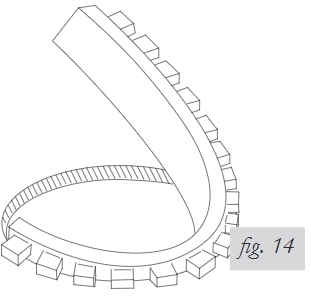
After the hole is drilled and before you route the harness to through the firewall, insert the grommet and “walk” the material around the inside edge of the drilled hole. You may have to trim the grommet to get an exact fit. (The flexible grommet is in the sealed parts package.)
c. When routing the wiring harness, it should not be routed so as to lay on, or near, the exhaust pipe/muffler/catalytic convertor of the vehicle. Routing along the top of a crossmember or over a heat shield is recommended.
5. The next connection is between each air spring and the air line “T” fitting.
a. With the air springs deflated, use a hose cutter to cut the air line already installed between the air springs and the inflation valves.
b. Install the provided “T” fittings (fig. 1) by pushing the air line into each leg of the “T” until you feel a definite “click”. Each line should go in 9/16”.
c. Connect a single length of air line to the open leg of the “T”. Connect as shown in the pneumatic schematic.
d. Route the air line across the chassis from the far side over the exhaust system heat shields and along the frame up to the compressor. Avoid heat sources, sharp edges, and tight bends. fig. 14 After the hole is drilled and before you route the harness to through the firewall, insert the grommet and “walk” the material around the inside edge of the drilled hole. You may have to trim the grommet to get an exact fit. (The flexible grommet is in the sealed parts package.) fig. 13 Load Controller / Single MN-750 11 NOTE CAUTION
e. Route air lines into cab from “T” fitting and attach to pressure switch assembly as shown in the pneumatic schematic.
f. Route air lines from low pressure switch to gauge barb.
g. Press air line over gauge barb. Water or lube may assist in securing air lines over the barb. A circular motion will assist in installation.
6. Connect the power wire to fused ignition.
a. Route it to the vehicle fuse box.
b. Determine which open terminal (accessory, etc.) works only when the key is in the “on” or accessory position (or refer to the owners manual for an available accessory fuse). The terminal should have an amperage rating higher than the 15 amp in-line fuse.
c. Connection to the fuse terminal will depend on what type of fuse your vehicle uses. If your vehicle uses the barrel type fuse, use adapter #1. If you have the standard spade type fuses, use adapter #2. Many late model vehicles use a smaller spade type fuse which requires adapter #3 (fig. 15). If you use adapter #1 or #2 you will need to crimp on a 1/4” (14-16GA) female connector supplied in kit. If you use adapter #3 you will need to crimp on 3/16” (14-16GA) female connector supplied in kit. The harness comes with blunt cut wire so no cut-off is necessary. Just crimp the wire right to the connector.

Connect adapter to “HOT” side of the fuse. With the ignition on, the compressor will turn on and fill the system to 10 PSI before shutting off.
7. Press the off/on button to inflate both air springs and use the small deflate button to adjust the pressure. Inflate to 30 PSI (20 PSI for Air Lift 1000 kits). Check all fittings and inflation valve cores with a solution of 1/5 dish soap to 4/5 water in a spray bottle for leaks. IMPORTANT: If the compressor runs continually or often, then there is a leak. Disconnect the compressor at the fuse box and test for leaks with a soapy water solution. NEVER RUN THE COMPRESSOR LONGER THAN FOUR MINUTES CONTINUOUSLY. ALLOW AT LEAST FIVE MINUTES FOR COOL DOWN BEFORE STARTING THE COMPRESSOR AGAIN.
